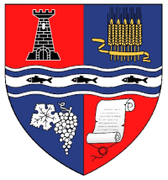Biharia
| Biharia Bihar | ||
|---|---|---|
| Commune | ||
| ||
 Biharia Location within Romania | ||
| Coordinates: 47°9′13″N 21°55′18″E / 47.15361°N 21.92167°E | ||
| Country |
| |
| County |
| |
| Commune | Biharia | |
| Historic region | Transylvania | |
| Government | ||
| • Mayor | Nagy Gizella (since 2008) (Democratic Union of Hungarians in Romania) | |
| Area | 58,50 km2 (2,260 sq mi) | |
| Population (2002)[1] | 5,870 | |
| Time zone | EET (UTC+2) | |
| • Summer (DST) | EEST (UTC+3) | |
| Website | www.comunabiharia.ro | |
Biharia (Hungarian: Bihar) is a commune in Bihor County, northwestern Romania. It is composed of two villages, Biharia and Cauaceu (Hegyközkovácsi). In 2002 it had 5,870 inhabitants, of whom 85.87% were Hungarians, 12.12% Romanians and 1.73% Roma.[2]
History
The village is first mentioned in 1067 as Byhoriensis, later as Bychor in 1213, as Bihar in 1332, and again, in 1349 as Byhor. It has a complex political history with periods of Ottoman rule, periods of Habsburg Monarchy, Principality of Transylvania, Kingdom of Hungary and Kingdom of Romania. After the Austro-Hungarian Compromise of 1867, it became part of the Kingdom of Hungary within Austria-Hungary.
After break-up of Austria-Hungary in 1918/1920, the commune became part of Romania. As a result of the Second Vienna Award it returned to Hungary between 1940 and 1944. Since then it has been part of Romania.
Sights
- Biharia Citadel built in the 9th century, historic monument[3]
Coordinates: 47°09′13″N 21°55′18″E / 47.15361°N 21.92167°E
References
- ↑ Romanian census data, 2002; retrieved on March 1, 2010
- ↑ http://www.edrc.ro/recensamant.jsp?regiune_id=2140&judet_id=2141&localitate_id=2158
- ↑ scribd.com - Cetatea Bihariei, judeţul Bihor; retrieved on June 30, 2012 (Romanian)

